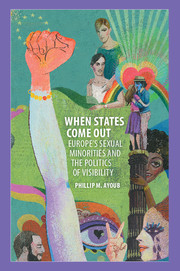Book contents
- Frontmatter
- Dedication
- Contents
- List of figures
- List of tables
- Preface and acknowledgments
- List of abbreviations
- 1 Introduction
- 2 The politics of visibility and LGBT rights in Europe
- 3 Transnational movement: Opportunities, actors, and mechanisms
- 4 Complying with new norms: LGBT rights legislation
- 5 Internalizing new norms: Attitudes toward sexual minorities
- 6 Poland and Slovenia's responses to international norms
- 7 Visibility in movement and transnational politics
- Methodological appendix
- References
- Index
- Books in the Series (continued from p. iii)
Methodological appendix
Published online by Cambridge University Press: 05 May 2016
- Frontmatter
- Dedication
- Contents
- List of figures
- List of tables
- Preface and acknowledgments
- List of abbreviations
- 1 Introduction
- 2 The politics of visibility and LGBT rights in Europe
- 3 Transnational movement: Opportunities, actors, and mechanisms
- 4 Complying with new norms: LGBT rights legislation
- 5 Internalizing new norms: Attitudes toward sexual minorities
- 6 Poland and Slovenia's responses to international norms
- 7 Visibility in movement and transnational politics
- Methodological appendix
- References
- Index
- Books in the Series (continued from p. iii)
Summary
Research methods and data collection
Research methods
In my research design, I employed an eclectic multimethod (quantitative and qualitative) approach. I used a nested analysis technique, which began with the large-n statistical test of correlation between variables and then, depending on the results, proceeded to either “model-testing” or “model-building” small-n analysis (Lieberman 2005, 436). The project included large-n analyses that used statistical methods to test correlations between predictors in all EU member states, and small-n analyses that used qualitative methods to trace channels of diffusion between carefully selected case studies. I thus used a triangular design in which the preliminary large-n analyses identified a set of ideal cases (on the regression line) for the small-n analysis, which I used to test the theory and to understand the mechanisms by which ideas diffuse.
I first constructed the data sets for preliminary quantitative analyses (final versions appear in Table A.1 and Table A.3). Next, I turned to qualitative methods in order to confirm or question the validity of the correlations I observed in the large-n analysis. This allowed me to answer open questions of causal order, measurement, and the heterogeneity of cases. I followed the principle that in triangulation “the best use of [small-n analysis] is to leverage its distinct complementarities with [large-n analysis], not to try to implement it with the exact same procedures as one would carry out regression analysis” (Lieberman 2005, 440). In this sense, the small-n analyses also allowed me to observe the mechanisms that connected the independent and dependent variables, aiding my understanding of historical sequence and causal process (McAdam, Tarrow, and Tilly 2001).
In a paired comparison, I chose Poland and Slovenia because my initial analysis revealed that, among new EU member states, these historically Catholic states were on opposite ends of the spectrum in terms of legal standing and societal attitudes toward LGBT people. Both cases had variation on the explanatory and dependent variables. I also studied Germany and the EU as “norm entrepreneur” cases, because I identified them as sources of horizontal and vertical diffusion, respectively. These cases served as mobilizing structures for activism in CEE. They illustrated how ideas diffused, with activists using resources available to them in one context to mobilize in another.
- Type
- Chapter
- Information
- When States Come OutEurope's Sexual Minorities and the Politics of Visibility, pp. 225 - 246Publisher: Cambridge University PressPrint publication year: 2016

